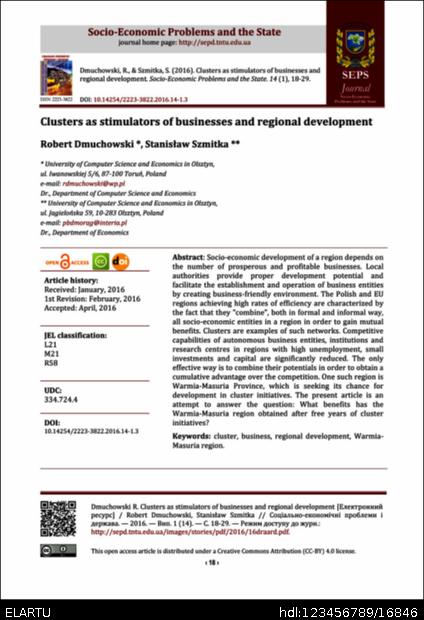Будь ласка, використовуйте цей ідентифікатор, щоб цитувати або посилатися на цей матеріал:
http://elartu.tntu.edu.ua/handle/123456789/16846

| Назва: | Clusters as stimulators of businesses and regional development |
| Автори: | Dmuchowski, Robert Szmitka, Stanisław |
| Приналежність: | University of Computer Science and Economics in Olsztyn, ul. Iwanowskiej 5/6, 87-100 Toruń, Poland |
| Бібліографічний опис: | Dmuchowski R. Clusters as stimulators of businesses and regional development [Електронний ресурс] / Robert Dmuchowski, Stanisław Szmitka // Соціально-економічні проблеми і держава. — 2016. — Вип. 1 (14). — С. 18-29. — Режим доступу до журн.: http://sepd.tntu.edu.ua/images/stories/pdf/2016/16draard.pdf. |
| Bibliographic description: | Dmuchowski, R., & Szmitka, S. (2016). Clusters as stimulators of businesses and regional development. Socio-Economic Problems and the State. 14 (1), 18-29. doi:10.14254/2223-3822.2016.14-1.3 |
| Є частиною видання: | Соціально-економічні проблеми і держава Socio-Economic Problems and the State |
| Журнал/збірник: | Соціально-економічні проблеми і держава |
| Випуск/№ : | 1 |
| Том: | 14 |
| Дата публікації: | 30-тра-2016 |
| Дата подання: | січ-2016 |
| Дата внесення: | 5-чер-2016 |
| Місце видання, проведення: | Україна, Тернопіль Ukraine, Ternopil |
| DOI: | 10.14254/2223-3822.2016.14-1.3 |
| УДК: | 334.724.4 |
| JEL: | L21 M21 R58 |
| Теми: | cluster business regional development Warmia-Masuria region |
| Кількість сторінок: | 12 |
| Діапазон сторінок: | 18-29 |
| Початкова сторінка: | 18 |
| Кінцева сторінка: | 29 |
| Короткий огляд (реферат): | Socio-economic development of a region depends on the number of prosperous and profitable businesses. Local authorities provide proper development potential and facilitate the establishment and operation of business entities by creating business-friendly environment. The Polish and EU regions achieving high rates of efficiency are characterized by the fact that they “combine”, both in formal and informal way, all socio-economic entities in a region in order to gain mutual benefits. Clusters are examples of such networks. Competitive capabilities of autonomous business entities, institutions and research centres in regions with high unemployment, small investments and capital are significantly reduced. The only effective way is to combine their potentials in order to obtain a cumulative advantage over the competition. One such region is Warmia-Masuria Province, which is seeking its chance for development in cluster initiatives. The present article is an attempt to answer the question: What benefits has the Warmia-Masuria region obtained after free years of cluster initiatives? |
| URI (Уніфікований ідентифікатор ресурсу): | http://elartu.tntu.edu.ua/handle/123456789/16846 |
| ISSN: | 2223-3822 |
| Власник авторського права: | © Socio-Economic Problems and the State, 2016 |
| URL-посилання пов’язаного матеріалу: | http://sepd.tntu.edu.ua/images/stories/pdf/2016/16draard.pdf |
| References: | 1. Adamkiewicz-Drwiłło, H. (2010). Konkurencyjność przedsiębiorstw w świetle uwarunkowań współczesnej gospodarki [The competetiveness of companies in the present economy], TNOiK, Toruń. 2. Baza Danych Eurostat [Eurostat Data Base], 2008, 2010, 2011, 2012, 2013. 3. Christensen, C. (2010). Przełomowe innowacje [Groudbreaking innovations]. PWN, Warszawa. 4. Chojnicki, Z. (1996). Ośrodki innowacji i przedsiębiorczości w Polsce [Innovation and enterprises centres], Poznań. 5. Cohen, D., & Prusak, I. (2001). In Good Company, Boston: Harvard Business School Press. 6. Drucker, P. (1992). Innowacja i przedsiębiorczość [Innovation and enterprises]. PWE, Warszawa. 7. Duraj, J. (2010). Przedsiębiorczość i innowacyjność [Enterprises and innovation]. Difin, Warszawa. 8. European Commission (2003). Enterprise Directorate General, Final report of the expert group on enterprise clusters and networks, Bruksela. 9. Faulkner, D., & Bowman, C. (1996). Strategie konkurencji [Competitiveness strategy], Gebether i Spółka Warszawa. 10. Jurek– Stępień, S. (2009). Rynkowe strategie konkurencyjności przedsiębiorstwa [Market strategic competetiveness of company], Novum, Płock. 11. Kasprzak-Lubińska, B. (2009). Klastry w województwie warmińsko-mazurskim [Clusters in the Warmia and Masuria Province], PARP, Warszawa. 12. Lancaster, G. (1993). Marketing management, McGraw-Hill, London. 13. Główny Urząd Statystyczny [Central Statistical Office], 2008, 2010,2011, 2012,2013. 14. Mellor, R.B. (2011). Przedsiębiorczość [Enterprises], PWE, Warszawa. 15. Oleksiuk, A. (2009). Konkurencyjność regionów a parki technologiczne i klastry przemysłowe [Competetiveness of regions, technological parks and industrial clusters], Branta, Bydgoszcz. 16. Parysek, J. (1997). Podstawy gospodarki lokalnej [The fundamentals of local economy], Poznań. 17. Penc, J. (2006). Zarzadzanie innowacyjne. Sterowanie zmianami w procesie integracji europejskiej [Innovation management. Change control in European integration process], WSSM, Łódź. 18. Raport o innowacyjności województwa warmińsko-mazurskiego w 2007 roku [Report on Innovation of Warmia and Masuria Province in 2007], Warszawa, 2008. 19. Skawińska, E., & Zalewski, R. (2009). Klastry biznesowe w rozwoju konkurencyjności i innowacyjności regionów [Business clusters in the development of competetiveness and innovations of regions], PWE, Warszawa. 20. Światalski, W. (2005). Innowacje i konkurencyjność [Innovation and competetiveness], WUW, Warszawa. |
| Тип вмісту: | Article |
| Розташовується у зібраннях: | Журнал „Соціально-економічні проблеми і держава“, 2016, Випуск 1(14) |
Файли цього матеріалу:
| Файл | Опис | Розмір | Формат | |
|---|---|---|---|---|
| 16draard.pdf | 893,58 kB | Adobe PDF | Переглянути/відкрити | |
| 16draard.djvu | 756,36 kB | DjVu | Переглянути/відкрити | |
| 16draard__COVER.jpg | 197,89 kB | JPEG | Переглянути/відкрити |
Усі матеріали в архіві електронних ресурсів захищені авторським правом, всі права збережені.